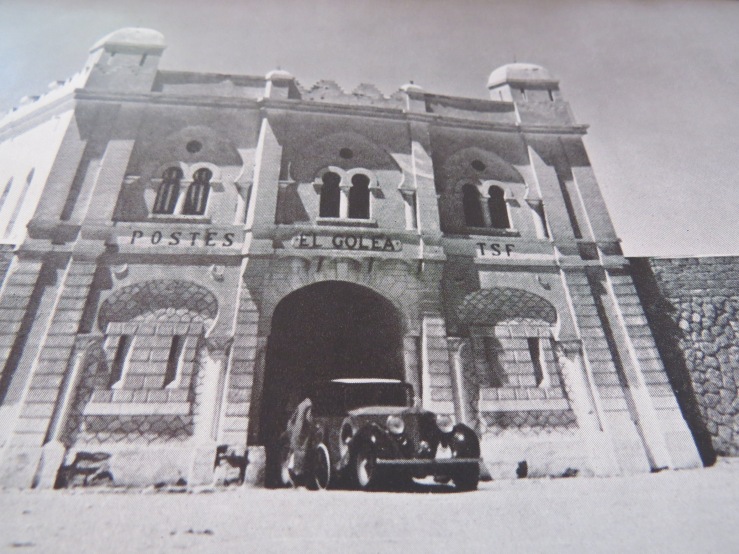 Ghardaia – El Golea
Ghardaia – El Golea
Bertie seemed to be a stickler for timing!
We left Ghardaia, refreshed by our good dinner, at 3 minutes past ten, winding our way slowly out of the sleeping town: and out on to the Southward track. In 14 miles, we climbed up a winding precipitous escarpment on to the plateau on which is the aerodrome of Ghardaia. We failed to see, in the darkness the next two logging points in our schedule, called respectively “Well 750 yards on right” and ”Hassi Gonselouda (well).” Humfrey was annoyed about this, but I ask you to be fair. How can one be expected to see a well 750 yards away from the track in the middle of the night? The track was in terribly bad condition and we felt that we were making very slow progress, but we kept reminding each other that we had noted on our previous trip that the track suddenly became very much better when we passed a signboard which said “Poste El Golea Limite”.
This did not, of course, mean that there was a speed limit: it merely meant that one had passed from the Ghardaia area to the El Golea area. We never saw this confounded post at all and were at last compelled to admit that we must have passed it without seeing it and, worse still, the track did not improve. Instead, we struck corrugations which had certainly not been here two years before. (This was when Bertie and Humfrey had done the Rolls Royce trip). We travelled on over those hideous ridges and hollows, and at last were cheered to recognize what appears in the log as HI DVAFOU WELL. It is simply a well surrounded by concrete walls, standing by the side of the rack, but we identified it simultaneously. I think that HI really should have been Hassi or well, but am not sure.
After they passed Hi Djafon, Bertie noted that steering column felt loose and they were able to rectify the problem- but Bertie was concerned about the loss of 18 minutes. This was their only involuntary stop between Algiers and Kano – over 2200 miles.
The expected improvement in the track did not take place and it began to be increasingly clear to us that something must have happened to alter conditions so much from our recollections of the past. When we came along here two years before in the Rolls Royce we had found a good, hard, smooth surface, so that we were able to travel mostly at quite high speeds 50 – 60m.p.h; whereas now we were struggling to keep up 38 to 40. We were becoming convinced that, if conditions throughout the desert crossing had deteriorated to this extent, it was going to be quite impossible even to approach the times we had set ourselves to accomplish. Anyway we were proceeding, even if not as fast as we wished.
We passed our next logging point “Onangle Track comes in on Left” and the remaining 60 miles to El Golea were simply a struggle against the rough broken condition of the track. At last we cautiously descended the steep winding stony hill to El Golea.
He goes on to describe the simple beauty of El Golea under the silver light of the full moon and how large El Golea is – over 5 – 6 square miles with the scent of millions of flowers. They booked into a magnificent hotel run by M. Desnoyens, an ex sergeant-major of the Foreign Legion and he is described as a ‘prince of hotel-keepers’.
Below is a picture from the Rolls Royce trip two years previously.

True, we were late. Our schedule time for arriving at El Golea was 10.35, as we had not intended stopping for dinner at Ghardaia but had a late supper here. It was now 3.53 in the morning. Our scheduled time for the 187 miles from Ghardaia was 5 hours and 5 minutes, whereas we had taken 5 hours and 50 minutes: 45 minutes slow of which 18 minutes had been lost replacing the clip on the steering column: still, we had averaged 32 m.p.h.
We had decided before arriving at El Golea that we would merely fill up with petrol and go straight on but when we broached this with Desnoyens he seemed so heartbroken that we agreed at least to drink some of the coffee he had prepared for us. We did not waste much time over it; we refilled with petrol, drank our coffee, ate some biscuits, and were off again in 32 minutes. We could now see our position again with reference to our schedule time. We had been due to leave El Golea at 11.50 p.m. whereas it was now 4.25a.m, so we were 4 hours 35 minutes behind schedule. We had travelled 572 miles since the day before and, excluding the 2½ hours lost before we left Algiers, we had only lost 2 hours. Not good, but not bad.
I should mention that, on our remarking to Desnoyen’s comment on the bad shape of the track, he told us that there had been very heavy and unprecedented rain and that the track further on was very much worse!
I must at this point say that I would love to know where Bertie’s book recording the predicted and actual times of departure and arrival is. Anybody got ideas about where one could start looking?